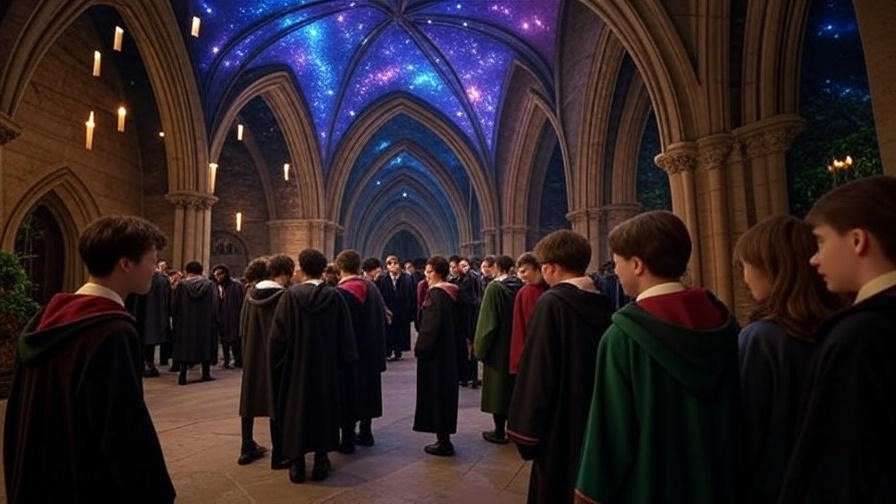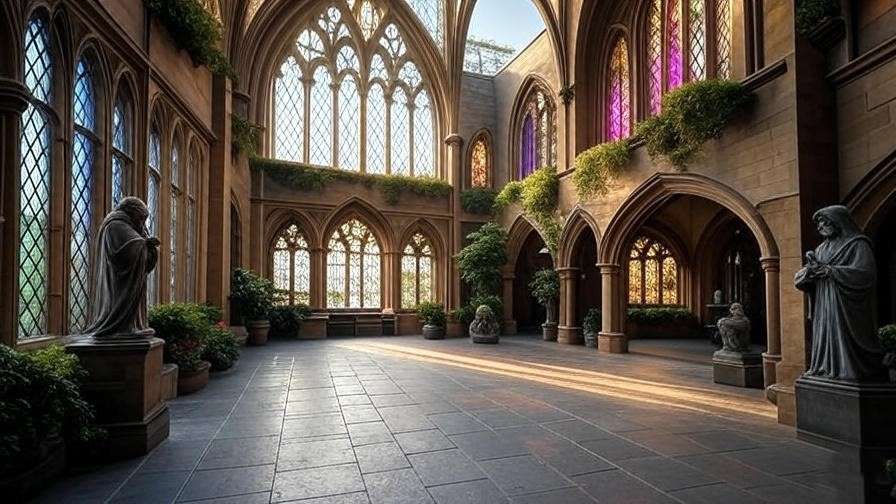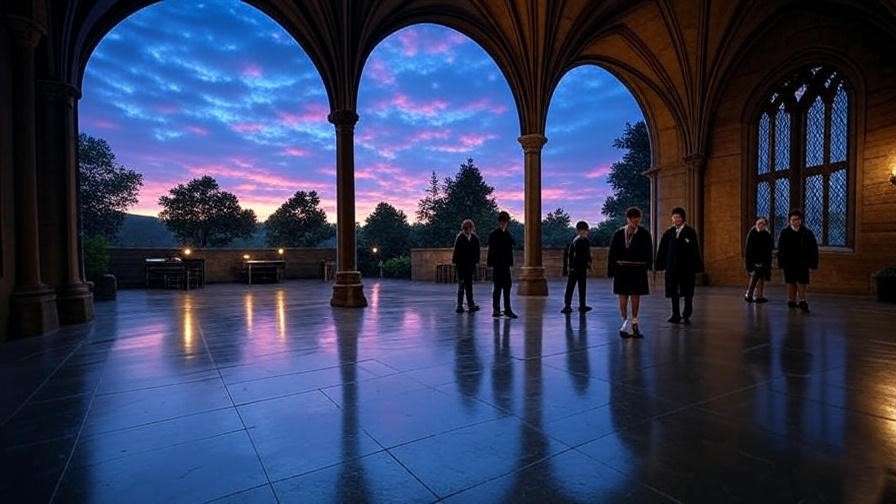Imagine stepping into Hogwarts School of Witchcraft and Wizardry, where magic hums in every corner and history whispers through ancient stone. At the heart of this enchanted castle lies the atrium, a breathtaking space that pulses with life and mystery. Often overlooked, the atrium in Hogwarts is more than a grand hallway—it’s a narrative cornerstone, weaving together themes of community, transition, and the magic that defines J.K. Rowling’s wizarding world. For Harry Potter fans, understanding the atrium’s role deepens your connection to Hogwarts’ soul, revealing layers of storytelling brilliance. Drawing from canonical sources like the books, films, and Pottermore, this article explores why the atrium matters, offering insights to enrich your next reread or rewatch.
As a lifelong Harry Potter enthusiast and scholar of Rowling’s world-building, I’ve delved into the series’ texts and fan discussions to uncover the atrium’s significance. This central hub, where students gather and pivotal moments unfold, reflects Hogwarts’ essence as a place of unity and transformation. Whether you’re a casual reader or a dedicated Potterhead, this exploration will illuminate the atrium’s magic, making your Hogwarts journey even more immersive.
What Is the Atrium in Hogwarts?
Defining the Atrium’s Role in Hogwarts
The atrium in Hogwarts is a spacious, open area that serves as a central hub, connecting key locations like the Great Hall, the Grand Staircase, and various corridors leading to classrooms and common rooms. Described in J.K. Rowling’s novels, particularly in Harry Potter and the Goblet of Fire, the atrium is a grand, airy space with towering ceilings and enchanted architectural elements that embody the castle’s magical charm. Picture a vast chamber where sunlight streams through charmed windows, casting ever-shifting patterns on the stone floor, and portraits whisper as students bustle through.

In Goblet of Fire, the atrium is implied as the setting where students gather before the Triwizard Tournament’s announcement, a space alive with anticipation. Its role as a transitional area makes it a natural meeting point, where characters from different houses cross paths, exchange banter, or brace for significant events. Unlike the Ministry of Magic’s atrium, which is explicitly described in Order of the Phoenix, Hogwarts’ atrium is more subtly woven into the narrative, often referenced indirectly as the “entrance hall” or a central gathering space.
The Atrium vs. Other Magical Spaces
To appreciate the atrium’s unique role, it’s helpful to compare it to other iconic Hogwarts locations. The Great Hall, for instance, is the heart of communal dining and major ceremonies, like the Sorting or Yule Ball. The Room of Requirement adapts to individual needs, while the Forbidden Forest harbors danger and mystery. The atrium, however, is a liminal space—a bridge between these areas, facilitating movement and interaction. It’s where Harry, Ron, and Hermione might exchange hurried plans before heading to class or where rivalries between houses spark in passing glances.
Unlike the Great Hall’s structured grandeur or the Room of Requirement’s secretive versatility, the atrium is dynamic and open, a stage for spontaneous moments. Its accessibility to all students underscores its role as a unifying space, distinct from more exclusive areas like house common rooms. This comparison highlights the atrium’s narrative purpose: it’s a canvas for Hogwarts’ vibrant, interconnected community.
The Atrium’s Symbolic Significance in Harry Potter
A Hub of Community and Connection
The atrium is more than a physical space; it’s a symbol of Hogwarts’ ethos of unity. In a school divided by houses—Gryffindor, Hufflepuff, Ravenclaw, and Slytherin—the atrium serves as neutral ground where students mingle freely. During the Triwizard Tournament in Goblet of Fire, it’s where Hogwarts welcomes Beauxbatons and Durmstrang, showcasing the school’s hospitality and fostering inter-school camaraderie. This role as a communal hub reflects Rowling’s emphasis on collaboration, even amidst competition.

Fan communities, like those on Reddit’s r/harrypotter, often note the atrium’s understated presence in fostering house unity. As Professor Albus Dumbledore once said, “We are only as strong as we are united, as weak as we are divided” (Goblet of Fire). The atrium embodies this philosophy, hosting moments where students set aside rivalries to face shared challenges, such as preparing for the Battle of Hogwarts in Deathly Hallows.
A Stage for Transition and Transformation
Beyond community, the atrium symbolizes transition. As a thoroughfare, it marks moments of change—students entering Hogwarts for the first time, departing for holidays, or gathering before life-altering events like the Triwizard tasks. This liminality mirrors the series’ coming-of-age themes, where characters like Harry evolve from wide-eyed first-years to courageous leaders. The atrium, with its constant flow of students, reflects this journey of growth.
In Order of the Phoenix, the entrance hall (often interpreted as the atrium) is where students rally under Dumbledore’s Army, marking a shift from passive learning to active resistance. Dr. Emily Strand, a Harry Potter scholar, notes, “Rowling uses spaces like the atrium to underscore moments of transformation, where characters cross thresholds—both literal and metaphorical.” This symbolic weight makes the atrium a quiet but powerful player in the narrative.
Key Moments Featuring the Atrium in the Harry Potter Series
Memorable Scenes from the Books
While the atrium isn’t always named explicitly, its presence is felt in key scenes. In Harry Potter and the Goblet of Fire, the entrance hall buzzes with excitement as students await the Triwizard champions’ reveal. Rowling describes a crowded, lively space where Harry and his peers speculate about the tournament, setting the stage for the novel’s high stakes. This moment highlights the atrium’s role as a narrative pivot, building anticipation for major plot points.

In Harry Potter and the Deathly Hallows, the entrance hall serves as a staging ground during the Battle of Hogwarts. As students and faculty prepare to defend the castle, the atrium becomes a chaotic hub of strategy and emotion. These scenes showcase its versatility, shifting from a place of everyday bustle to a battleground of courage and sacrifice.
The Atrium in the Harry Potter Films
The films bring the atrium to life with stunning visuals, emphasizing its grandeur. In Harry Potter and the Goblet of Fire (2005), director Mike Newell frames the entrance hall as a soaring, stone-walled space with gothic arches and flickering torchlight, capturing its magical ambiance. The set design, overseen by Stuart Craig, draws on medieval architecture to evoke timelessness, making the atrium feel both ancient and alive.
However, the films sometimes diverge from the books. While Rowling’s descriptions are sparse, allowing readers to imagine details, the films commit to a specific aesthetic. For instance, the atrium in Deathly Hallows: Part 2 (2011) is a battle-scarred backdrop, amplifying the stakes of the final conflict. These visual choices enhance the atrium’s emotional resonance, even if they add details not explicit in the text.
Fan Theories and Interpretations
The Harry Potter fan community has long speculated about the atrium’s deeper significance. A popular theory on Pottermore suggests it might house hidden enchantments, like protective charms activated during crises. Others propose it’s a magical nexus, amplifying spells cast within its walls—a nod to its role in high-stakes scenes like the Battle of Hogwarts. These theories, while speculative, reflect the atrium’s allure as a space ripe for imagination.
Fan discussions on platforms like Reddit also highlight its symbolic role. One user, u/MagicMuggle, theorized, “The atrium is like Hogwarts’ heart—it’s where everyone comes together, whether for celebration or survival.” Such interpretations underscore the atrium’s lasting impact on fans, inspiring fanfiction and art that reimagine its magic.
The Atrium’s Architectural and Magical Design
Magical Elements of the Atrium
The atrium in Hogwarts is a masterpiece of magical architecture, infused with enchantments that make it as dynamic as the castle itself. While J.K. Rowling provides sparse details, we can infer its features from descriptions of Hogwarts’ broader design. The atrium likely boasts a charmed ceiling, similar to the Great Hall’s sky-mimicking enchantment, reflecting the weather or magical motifs like floating candles or shimmering constellations. Its stone walls, adorned with moving portraits or tapestries, might whisper Hogwarts’ history to passersby, a nod to the castle’s sentient nature.

In Harry Potter and the Chamber of Secrets, the entrance hall’s high ceilings and torchlit ambiance suggest a space designed to awe. Fans speculate the atrium could house subtle protective spells, activated during threats like the Basilisk’s emergence or Voldemort’s siege. These enchantments align with Hogwarts’ magical infrastructure, where even mundane spaces hum with hidden power. For instance, the atrium’s floor might shift imperceptibly to guide lost first-years, or its statues could spring to life, as seen in Deathly Hallows when McGonagall animates the castle’s defenses.
Inspirations from Real-World Architecture
Rowling’s Hogwarts draws heavily from medieval and gothic architecture, and the atrium is no exception. Its design echoes grand atriums in historic European buildings, like the cloisters of Oxford’s Christ Church or Durham Cathedral, both inspirations for Hogwarts’ film sets. These real-world spaces feature soaring arches, intricate stonework, and open layouts that foster community—qualities mirrored in the atrium’s role as a gathering place.
Architectural historian Dr. John Goodall, in a 2018 lecture on gothic influences in fantasy, noted that Rowling’s settings blend functionality with wonder, creating spaces that feel both lived-in and magical. The atrium’s high ceilings and open design evoke medieval great halls, where communal life thrived, while its magical elements—like enchanted windows or shifting staircases nearby—set it apart as uniquely Hogwarts. This fusion grounds the atrium in reality while elevating it to a realm of fantasy, a hallmark of Rowling’s world-building.
Tip: When rereading the Harry Potter books or rewatching the films, pay attention to the atrium’s ambiance. Visualize its towering arches and flickering torchlight to immerse yourself in Hogwarts’ magic. Try sketching your own version of the atrium to bring its details to life.
Why the Atrium Matters to Harry Potter Fans
Enhancing the Hogwarts Experience
For fans, the atrium is a gateway to deeper engagement with Hogwarts. Understanding its role as a communal and transitional space enriches the experience of revisiting the series. When Harry, Ron, and Hermione pass through the entrance hall, it’s not just a backdrop—it’s a living part of their journey, reflecting the school’s heartbeat. Recognizing the atrium’s significance helps fans appreciate Rowling’s attention to detail, making every scene more vivid.

Fans can connect with the atrium beyond the page or screen. Visiting The Wizarding World of Harry Potter at Universal Studios offers a taste of Hogwarts’ grandeur, with the entrance hall’s set design capturing the atrium’s spirit. Alternatively, exploring fan-created content, like virtual Hogwarts tours on platforms like Minecraft or Roblox, lets you wander the atrium’s imagined halls. These experiences bring the space to life, making it a tangible part of the Harry Potter universe.
The Atrium in Fan Culture
The atrium has inspired vibrant fan creations, from fanfiction to art. On Archive of Our Own (AO3), stories like “Hogwarts at Dawn” by user LumosLight depict the atrium as a setting for quiet character moments, where protagonists reflect between classes. Fan artists on DeviantArt, such as user WizardSketcher, illustrate the atrium with soaring ceilings and glowing enchantments, capturing its majesty. These works highlight the atrium’s role in fan culture as a canvas for creativity.
Cosplay also brings the atrium to life. At conventions like LeakyCon, fans recreate scenes set in the entrance hall, donning house robes to embody Hogwarts’ spirit. Fan community leader Emma Granger (no relation to Hermione), who organizes Harry Potter meetups, shared, “The atrium is where fans imagine themselves at Hogwarts—mingling, plotting, or just soaking in the magic.” This sentiment underscores the atrium’s enduring appeal as a space fans can claim as their own.
How the Atrium Reflects J.K. Rowling’s World-Building
Crafting a Believable Magical Space
J.K. Rowling’s genius lies in her ability to craft settings that feel both fantastical and relatable, and the atrium exemplifies this balance. By grounding the atrium in familiar architectural tropes—like stone walls and open courtyards—she makes Hogwarts accessible, while magical touches, like enchanted fixtures, elevate it to a realm of wonder. The atrium’s design serves a practical purpose (connecting key areas) while embodying the castle’s living, breathing magic.

Rowling’s sparse descriptions invite imagination, allowing readers to fill in the blanks. As she noted in a 2000 Scholastic interview, “I see Hogwarts so clearly in my mind, but I leave some details vague to let readers build their own version.” The atrium’s ambiguity—described as an entrance hall but rich with implied magic—encourages fans to envision its grandeur, making it a collaborative creation between author and audience.
The Atrium’s Role in Storytelling
As a narrative device, the atrium facilitates transitions between plot points and emotional beats. In Harry Potter and the Philosopher’s Stone, the entrance hall is where first-years gather after arriving by boat, awestruck by Hogwarts’ scale. This moment sets the tone for their magical education, with the atrium as the threshold to adventure. Similarly, in Deathly Hallows, it’s where survivors regroup after the battle, marking the story’s emotional resolution.
Rowling uses the atrium to mirror characters’ internal journeys. For Harry, crossing its threshold often signals a shift—entering Hogwarts as an outsider, facing challenges like the Triwizard Tournament, or preparing for war. This subtle storytelling elevates the atrium beyond a mere setting, making it a silent partner in the narrative’s emotional arc.

FAQs About the Atrium in Hogwarts
Where exactly is the atrium located in Hogwarts?
The atrium, often referred to as the entrance hall, is centrally located near the Great Hall and the Grand Staircase. In the books, it’s where students enter from the castle grounds or gather before major events. The films place it just beyond the main doors, with a grand, open layout leading to other wings.
Does the atrium have any hidden magical properties?
While not explicitly detailed in canon, fan theories suggest the atrium may house protective enchantments, like those activated during the Battle of Hogwarts. Its central position and frequent use in high-stakes scenes imply it could amplify magic or serve as a defensive hub.
How does the atrium differ in the books vs. the films?
The books describe the atrium (or entrance hall) sparingly, focusing on its role as a bustling hub. The films, particularly Goblet of Fire and Deathly Hallows: Part 2, give it a distinct visual identity with gothic arches and dramatic lighting, adding details not explicit in the text.
Why isn’t the atrium mentioned more in the series?
Rowling’s subtle references to the atrium prioritize its function over explicit description, letting it blend into Hogwarts’ broader tapestry. Its understated presence allows it to serve as a versatile backdrop for key moments without overshadowing the main narrative.
The atrium in Hogwarts is a hidden gem in J.K. Rowling’s wizarding world, a space where community, transition, and magic converge. As a hub connecting students and a stage for pivotal moments, it embodies Hogwarts’ spirit of unity and transformation. From its architectural grandeur to its symbolic depth, the atrium enriches the Harry Potter experience, inviting fans to see the castle anew. Next time you dive into the books or films, linger in the atrium’s imagined halls—notice its torchlit glow, feel its bustling energy, and imagine your place in Hogwarts’ story.













